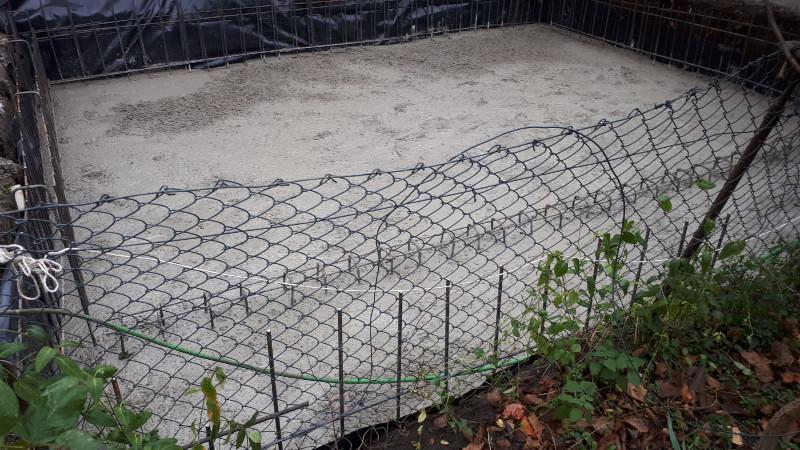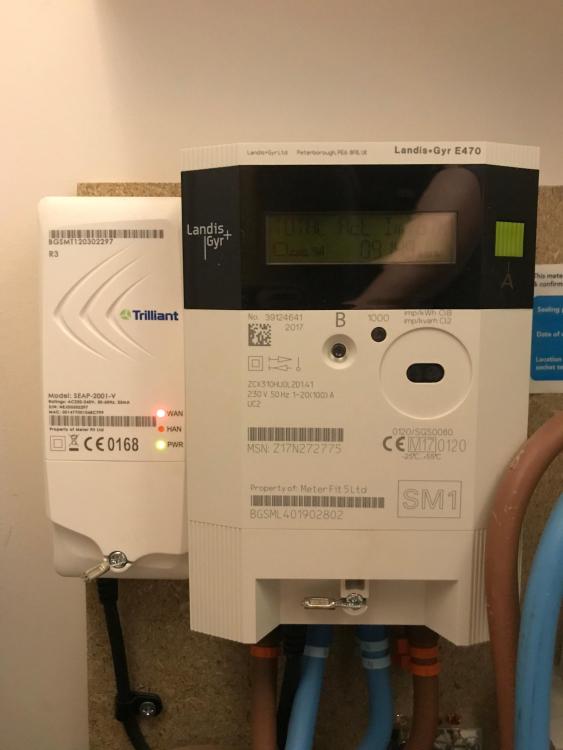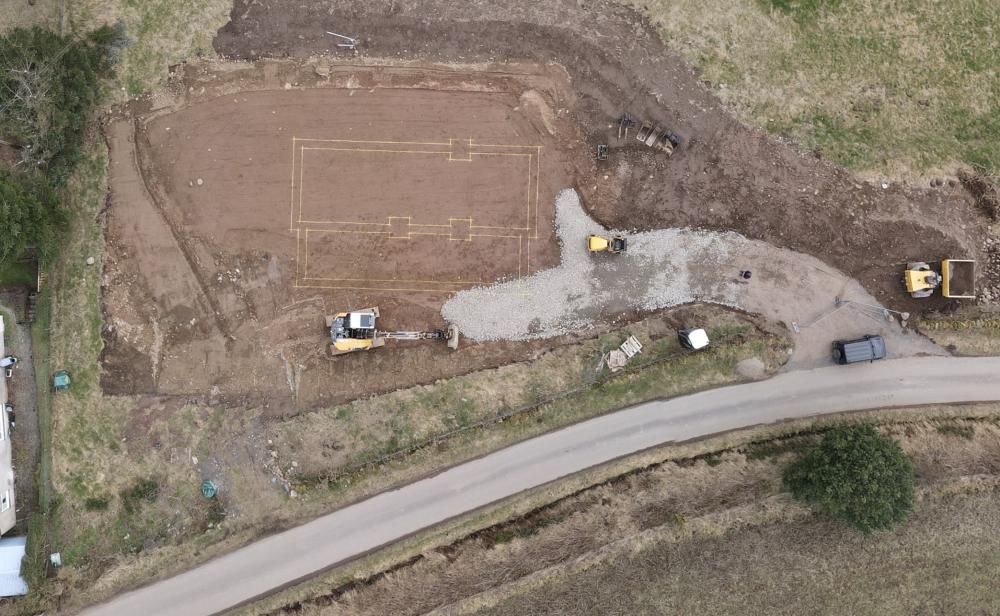Leaderboard
Popular Content
Showing content with the highest reputation on 04/17/23 in all areas
-
Well, it's really happening. HID left work last Friday, spent the weekend fixing the horses fencing, but it didn't matter as he can now work on the build. I've created a very detailed project plan for his for 3 days and intend to keep this going as he works much better this way. This will approximate timings which will no doubt go out the window. We did have an issue last week, he had dug a trench, we had torrential rain and one side fell in, some of our soil is very sandy so fine to build on, but need almost digging, inspecting and filling in one day. He has today dug the main parts of the first trenches and BC are coming Thurs am to look with concrete coming Thur lunchtime and then BC coming back later to look at this as he's got a local inspection as one of the local mansions for a few hours. Still lots to do for this, one end needs to be shuttered to allow for the underpinning, we need to fence the area for safely before someone (probably me) falls in. We need to put level markers for the depth and check if any of the sides need supporting. Luckily the weather is supposed to be good this week. Not a very big update, but so excited to be doing something except pouring over reports and plans.2 points
-
This is it - risk reduction vs elimination. Some of it is doing best possible research, some is ensuring the lowest risk payment method & terms. You will still get problems. We've probably had 3 major issues on our build. 1) render company used what was a BBA approved carrier board at the time of installation but turned out to have issues and has been quietly withdrawn by the major supplier. Impossible to pursue any action against the supplier and render company since gone out of business but were making best efforts to resolve. Latent defects insurance proved useless, refused to cover replacement cost which would be very substantial at today's prices (especially once the removal of existing and VAT added on). More of an aesthetic issue vs compromise of the rain screen (for now). 2) Glass balustrade company did all work contracted but final piece of glass incorrect. Went into receivership just after we noticed but as we'd been paying for work via credit card, got a resolution from our bank. 3) Groundworker firm clearly cut a few corners when reinstating basement (using spoil vs clean stone) when I was not around to supervise. Not obvious at time but the area to rear of house continues to settle and patio paving now a bit wonky, despite landscapers best efforts to create a stable surface. I with held the final 2.5% of bill due to other, more minor, quality issues at the time and the problem is manageable to resolve. You can't eliminate risk but you can soften the blow or, at a minimum, tell yourself that you did all you could to prevent - this is often the most difficult part of the experience to deal with.2 points
-
I prefer non complicated, each elevation it’s own (I.e. timber on left elevation and brick on the right.2 points
-
Which could also be filled with rocks, blebs of foam, and anything else that fit left in at the build / renovation / when the water board last dug up a pipe. I've seen a 50 mm pebble from there incoming mains wedge a 100 mm fill valve open on a tank for a big block of flats once. Created quite the swimming pool did that...1 point
-
The guys above know more about it than me. But think about it logically. During the groundworks phase you’ll have the right equipment on-site and the site will be turned over due to all the other works. It’s far better and cheaper to get your drainage done properly now than end up with a problem after the house is up when access is harder and you mess up the ground again. We’ve taken a lot of care over the drainage so far and even though the soakaway isn’t in yet we have a well drained site. Consequently it’s easy to work in as it’s dry even after heavy rain. When the house goes up, with its big roof added to the garage with its equally big roof, all that water needs to go somewhere. I wouldn’t be trusting some unknown soakaway that’s been there for years even if it saved a few thousand.1 point
-
If you are nailing it is often difficult to get 2 nails in because the slates are cut on the angle. They can get caught by the wind. The hooks prevent the bottom of the slate from lifting.1 point
-
I removed a Nissen style concrete asbestos garage a few years ago. As suggested if contact someone like Biffa and they can supply a sealed container. I hired a Genie type lift to lower the pieces down. Keep it well watered, now cutting with a saw.1 point
-
it's a liquid screed. already done the prep work for one load. i promise you the chance of getting the liquid screed under the DPM will be minimal but i'll be foaming all gaps between EPS sheets (if there are any) and taping them for good measure. the benefit of self-building is you can belt and braces everything! takes ******* ages though. just ask @pocster.1 point
-
IIRC the tape I used was 20mm wide. To ensure the seal is watertight, the gap to be filled, should be within the expansion range of the tape.1 point
-
I thought that, but then they call me poor ol SteamyTea1 point
-
I would think that excavating a metre, so that the ground floor was 1m lower with the ridge where it was always already going to be, is going to add costs for excavator, operator, muckaway lorries, more concrete (most of it waterproof), reinforcing steel, timber for formwork a lot of which could end up in your house, labour and concrete pumps. You will save something on footings. Are you in chalk? Will you find chalk 1m down? Chalk drains. Very advantageous for a basement structure. I did exactly this to be able to build a studio at the end of the garden without building any higher than the neighbour's shed. If 140 sq m like your neighbour: 13T excavator would dig this in a day but would need to hang around for 10 lorries to fill. Perhaps 3 days. About £900 with delivery and collection. (VAT zero rated if digger comes with its own operator) £450. 140 cubic metres of soil is about 10 trucks. About £3000. Or you could pay less for a smaller digger and pay more for grab lorries. Up to 60 cu m of waterproof concrete £12,000. Steel. Max 2 tonnes. Max £1000 with delivery. Timber about £3000. Less if you will have to buy some but you re-use this instead. Labour. I don't pay myself so I don't know. Perhaps £15,000? 2 pumps £1000. That totals about £36,000 plus you will have more cost fitting out the extra rooms in the roof - but that is the gain. Extra rooms, added house value. Less some of the cost of footings.1 point
-
You will need soakers on every course and lots of slate and a halves. Hook fixing may be good here.1 point
-
Think I'm hot on the trail of the problem. Found installation instructions for both mixers and they BOTH have non-return valves built in. So mighty relief as unlikely I will have to bash holes in walls after all. The flows are balanced, all mains pressure and near identical pipe runs. However the hot goes through a heat exchanger on a thermal store. Water from the store is circulated through through the other side of the heat exchanger by a pump triggered by a flow sensor on the cold pipe. Eg open a hot tap and the cold flow starts the heat exchanger pump. Annoyingly the issue seems to have gone very intermittent. I was able to trigger the fault once and check the flow sensor was calling for heat (it was) but it started working again before I could check if the heat exchanger pump was running. I'm leaning towards the pump or the supply to it being the cause but need it to fail more repeatedly to fault find it.1 point
-
None as they are internal. It has blocked the road though 😂 I’m glad no one was hurt which is the main thing1 point
-
i'm all for a sticky about due diligence but it still might not help some people. i did due diligence on our TF company (Flight Timber). i checked the accounts, filings at Companies House, spoke to previous customers, site visited a build in progress, did web searches. all looked good and they built me a good timber frame. a year later they were out of business and some on here got stung by that. so part of due diligence is looking for reviews and if some saw my reviews of how happy i was with the house then, it could be a major part of the decision to go with them only to lose money. so you could do all the due diligence in the world but still get stung. although i guess you reduce the risk of that happening.1 point
-
1 point
-
Well we will see when we get the quote. He is keen to get in to housebuilding and is well known and recommended so it seemed sensible to have a chat and give him the opportunity to pitch for the business.1 point
-
Count the LED pulses on the meters. Posted up details on how to do it.1 point
-
This makes it clearer. no problem with cutting the 3x2’s. Add a prop underneath to support the member you cut while you get the header or cross member/s in. This is to prevent the ceiling sagging when the members are cut. I would add additional angle brackets around the support points onto the trusses as these connections will not have been made with additional loft loads in mind. I’ve seen whole room sized areas of battens come away from the underside of trusses due to loft loading.1 point
-
1 point
-
Your switchgear ought not to be in the meter box. Meter box: [Cutout > Meter > DP Isolator] External box: [your own switchgear] Do you need fuses or could you get away with isolators? (physically smaller) https://www.toolstation.com/axiom-isolator-with-enclosure/p92544 Ideally you'd have an N-way board sat adjacent the meter cupboard (one mains incomer / double pole isolator; with MCBs to feed man cave / ev charge / solar pv etc and indeed house if it needs reducing to 63A for reasons of long consumer unit tails?) That would also delete the Henley block up at the top; and give you somewhere to terminal the SWA that looks to go to another box in the top tight hand side. Depends on exactly which meter they wish to fit but I think you'd get away with there being enough space if you can delete the "man cave" switchfuse and the henley cocks above it.1 point
-
Are you referring to "trickle" grid import, when there is plenty of battery energy stored up and/or plenty of PV/sun - yet there is a small delay before the inverter uses either the battery energy and/or PV and instead is using the grid for the first few seconds? I think this is called "ramp up" times when a load is first noticed by the inverter it takes a very small amount of time to start using either battery or PV power - and during this time the grid is used. There is a guy on youtube who talks briefly about this, EV Puzzle I think was his channel. It could be to do with load balancing with grid-tied inverters. It didn't appear to happen as much when he tested a Huawei inverter compared to another inverter (I can't remember the other brand) but the Huawei had much less of a ramp up time (less trickle grid import) compared to the other one. I believe Solax inverters also have a way of minimising ramp up times too. Another alternative is that all house loads run through the (EPS backup mode) batteries first and only when the batteries are nearly depleted or the load is too much for the inverter/batteries' maximum discharge rate only then does the grid temporarily cut in and meet that load demand - he called it a "grid parallel" set-up and Victron is good with this kind of set up although I see no reason why any hybrid inverter cannot also be set up in this way - as long as there is enough battery storage and the fuse on the EPS backup load is big enough. I am no expert on this but this is all from memory.1 point
-
1 point
-
Ok thanks for the info. I've decided to get a plumber out who has all the right equipment and can do the necessary tests and checks and help me find the leak. At least the I can have high confidence in the pipe work that's there. For the sake of a few hundred quid I think it will be well worth it. Thanks to everyone for all the help and advice.1 point
-
1 point
-
Yes, k (kilo, for thousand), W (watt, for joule, the unit for energy, divided by s, the unit of time) and h (hour, which is 3600 seconds). So take your batteries at 10.8 kWh, that is 10,800 J.s-1.3600 s-1 The s-1 cancel out, so 38,880,000 or 38.88 MJ. Life would be so easy if we discussed energy in joules.1 point
-
Yes there is an expectation that we will be doing some of the work, which we are fine with. I don't think a turnkey solution is within our budget! He is fairly new to the house building game, so there is an element of risk involved (which we hope will be reflected in the price). It is an area he wants to get in to and is very competent (we know previous clients). We will be asking to see previous work regardless. It's given us a starting point anyway.1 point
-
Probably around £2500k per sq m. We are planning to do a lot of the interior work ourselves P&D and bathroom installs. Could do kitchen, but would rather not. Landscaping we will do ourselves so would leave that out of the quote and see how much money we have left at the end.1 point
-
Can't really see any reason for going wider than that, particularly since (if I read you correctly) you are backing up with FM330.1 point
-
The mention of concrete footings suggest that there may be more than the 200mm RC slab, although at 150 years old it's unlikely to be the original foundation. If you can get an SE, engaged by you, to agree you're covered structurally. But, It looks to me from the first image that the eaves are relatively low. Is the top of the concrete slab level with the bottom of those doors? If you felt you had to use the existing slab, you are first going to need to get it level, if it's not already. Agricultural slabs will often have a fall on them to drain. If it's was built for animals then that fall may be quite significant. Once level you'll then need to build it up with insulation, a screed and your floor finishes. The Finished Floor Level is likely to be around 200mm above that levelled slab. If you then work from the plane of the current corrugated sheeting, which under Class Q you can't exceed, you'll need at least 300mm - 350mm thickness to the inside of the plasterboard. Is there sufficient headroom left inside once you account for the layers that need to be added for the conversion?1 point
-
Compriband is UV stable which may be or not important in some applications. I have used an alternative which worked for me with sealing windows but I don't know if it was the only sealing layer it would work very long term. https://www.affixit.co.uk/expanding-foam-tape-compriband-alternative.html1 point
-
He is not, the cylinder has a separate coil within it to allow you run a pressurised heating system.1 point
-
Take it that it's a 2 storey with hollowcore slabs you are going with judging by the detail. Could probably hold up a multistorey carpark😀1 point
-
1 point
-
I think the vendor will be in the business of selling these rather than ensuring that they live a long and happy life. Vac pump is as much for drying out the lines by boiling off any moisture under vacuum as it is for purging air. I'm sure it'll work fine though. I should add the ask no questions tell no lies minisplit kit to the tool loan page come to think of it. Vac pump, cutting too, flaring tool, cheapo gauges good only for checking vacuum/hooking up the vac pump. Annoying to post though as it'll barf out all the oil in the vacuum pump is tipped over and it'll take an age to drain it dry dry. Might have to be local only/hand relay only.1 point
-
This clarification is really helpful for those of us with little history on this forum, thank you. It makes me feel as each hour goes by that we perhaps were "lucky" to only lose our block deposit (and architect setting out fees and structural engineer fees!) and have a chance to look again at our build method.1 point
-
Standard JCT contract work on interim valuations which are then invoiced to the client, ie payment in arrears. Of course these can be amended, but it is not the norm for builders to need upfront payment.... Because their entire industry works on credit for the above reason. Walk into any builders merchants and ask for their credit terms, all will discuss, run credit checks and assess financial situation. Good builders generally will have no issues, bad builders won't generally get the credit... Hence a good way of vetting builders (to help OP) in advance. Advising a new starter to self building that paying up front is normal or encouraged is frankly dangerous, there are no shortage of horror stories on this forum where people have lost money due to builders/Companies taking money and then losing interest in the job. Most problem builds end up with the question 'I hope you haven't paid him' for this very reason....1 point
-
sounds like he's after you to project manage yourself if he's asking you to find people to supply and fit rather than being a main contractor and offering a turnkey solution. obviously, there's a lot of savings to be had by project managing but it is time consuming! normally, afaik, a main contractor will get his plumber/sparky/chippy to fit the stuff that you can source if you want. but I guess everyone is different and there's no one solution to this building malarky.1 point
-
It also depends on you - or your representative - checking it at the right stages, to identify and remedy the leaks. Don't underestimate the ability of the builders to install it incorrectly. Get the BBA certificates are check that they're being followed. The builder will just go to their regular suppliers and pay what they're invoiced, plus a mark-up to cover their time, effort & profit. If you have the time to shop around, particularly for high value items, you may make savings even if you do have to pay the VAT. Or arrange with your builder that you will identify certain suppliers and they'll buy the products at cost + an agreed markup.1 point
-
Get some references from them and interview the past clients. After some of the really awful stories on here about people loosing all their money so a trustworthy party is really important. Our builder wasn't the tidiest but honourable to a fault. A good individual who is fussy about their work can achieve excellent results so long as they are willing to learn old school or not.1 point
-
I'm seeing him tomorrow so I'll speak to him then and get back to you if that's ok.1 point
-
Timber Frame The F-- uck Tomorrow's Friday1 point
-
1 point
-
Some data on the install now that I have 32 days worth, for those interested: Modelled heat demand for that period was 1518kWh. This probably has a 10% error margin as it's just a multivariate regression of heating data before the ASHP went in Actual gas usage in that period minus estimated hot water usage was 475kWh. If anything the hot water estimate is likely to be pessimistic ASHP usage in that period was 200kWh So on average every 1kWh the ASHP used offset between 4.5 and 5.2kWh of gas 65-70% reduction in gas heating usage from the install of a single minisplit unit Assuming 90% boiler efficiency that gives a CoP estimate of 4.1-4.7, which compares well to the data sheet SCoP of 4.2 Minimum daily CoP estimate of 3.1, maximum of 6.1. There's been a good range of temperatures over this period to see behaviour over a real heating season, though obviously performance will be lower in winter months: Daily mean: 7.0°C Max: 10.9°C Min: 1.2°C. Lowest reading -4°C That's probably all the data I'll get for this heating season as we're getting into large solar gains from the conservatory which invalidates the heating model. Since moving to Octopus Flux everything the heat pump has used has effectively come from PV due to the import/export symmetry. So we've had ~1MWh of free heating from the solar panels, which sort of blows my mind. That's effectively paid back ~18% of the installed ASHP cost in one month. I couldn't be happier with the results of this little experiment, they've lined up perfectly with expectations. For balance, a few downsides of going with a cheap unit: The indoor unit housing is cheap and plasticy, but not offensively so Horizontal fan sweeping is manual only and no fancy occupier avoidance features like on the pricer brands Only the low fan speed is very quiet and the auto mode tends to have weird peaks of high fan speed when starting up etc. The outdoor unit has a slight vibration resonance in the housing, I have it well out the way so not an issue but I may add some damping pads at some point to eliminate it The Tuya wifi integration is a great little bonus and I have a control system written with the Python bindings for much finer control on scheduling which makes best use of the Flux tariff.1 point
-
Twin chamber tank, then soakaway then drainfield? Should be twin chamber tank and then drain-field for a traditional tank (not sure if the rules in Scotland are different). Surface water should not really be going into the tank, if it is, it means silt and leaves can also get in, it also means the smell coming from downpipes could be horrendous. Also means in an extreme downpour, there can be too much water in the tanks and cause untreated effluent to enter the drain-field causing it to block. With all the rain we had last year, this has probably happened.1 point
-
I thought I’d update my introduction. Hard to believe my first post was in July 2021! Suffice to say we achieved planning and got our warrant in December. Frustrating process largely down to the timber kit company and their incompetence, inexperience and general shoddy service. That’s a whole other story. The electricity supply ended up being extremely cheap costing us only £416 plus my time to dig the trench (6m on my neighbour’s land and 20m on ours) and a small foundation for the kiosk. Far cry from the £26.5k initial estimate. The water supply was slightly more complicated but eventually the farmer managed to successfully find water. Took two different drilling companies and a very deep hole (147m). The first few treatment plant quotes were almost laughable at £24k. I then attended a webinar organised by the Scottish Self-Build team and came across Filpumps from Aberdeen and they quoted £9k so that’s who we’ve gone with. Plant gets installed in a month or so once the garage goes up. The sewage side of things proved to be pretty straightforward. Percolation test was fine and the Goldilocks spot happens to be 50m from the borehole and 10m from the water course plus. We decided to go for a Graf One2Clean 7PE system with remote blower. Great price from JD Pipes. It gets installed in a few weeks. The big challenge was trying to find a groundswork company. Emailed 7 companies and got three quotes. Two of them took months to get and were horrendous. The guy we went with was £20k cheaper! He’s also very good and has come highly recommended even from the local BCO. I’ve been working my way through all the other elements, prelims, roofing companies, plumbing, electrical, joinery, ASHP, MVHR, PV and garage supplier. I’m pretty much there with all of them. Got a decision to make on plumber and joiner. Everything else is in place. We’ve also got the kitchen designed and ordered, bathrooms picked, and flooring mostly decided. Groundswork has started. We’ve cleared the site, levelled it, formed the driveway and did the setting out today. Foundation digging starts tomorrow. We should finish the foundations by third week of March. Bit of a break for a few weeks then the kit arrives on the 17 April. Garage goes up end of March. We have a decision to make about the small but long retaining wall which we’ll do this week and we need to make the drive wider.1 point
-
I definitely would. 5 years in and it still looks like new....almost everywhere.. We were very careful with it while the build finished, covering with a thin cortex sheeting, and giving all the trades mats or similar for putting doors, cabinets etc on to to avoid any accidents. We are still careful, in a similar way you would be with a wood floor. All our furniture has felt pads, outside shoes tend not to make it beyond the boot room. Our boot room gets very heavy use, we live on an ex-farm and have 3 young boys and two 60kg dogs. The floor gets filthy, and outside boots come in with stones in the soles. Even this floor will mop up and look excellent, if not quite brand new. In the boot room there are two surface scratches, that are noticeable as the dirt catches in them and our floor is a light grey. The scratches are our fault, a metal dog crate got dragged across it without thinking, but work boots haven't made any wear marks. We found a slight oddity with getting "dull" patches where we have some rugs and mats. Only just noticeable and seems to be worse if there's a backing on the rug/mat that is dark in colour. Remove the mat and these patches seem to fade away after a while. Overall, I would definitely have it again. The groutless/seamless finish leaves no dirt traps. We can leave a robovac to take away 95% of the daily detritus from children and dogs, and just mop it perhaps once a week and it stays looking spotless. If you accept it's not as hardy as a porcelain tile, it's a fantastic floor finish. I understand that it can go down on a suspended floor, but I believe there's more prep in the way of additional layers of, I think, ply to reduce the risk of any movement.1 point
-
Off to a great start. First load of timber kit fell off the tele-handler ffs0 points
-
I can't recall where I read it but I gathered that the thinking behind the 3m rule was that people coming out of a building would have an expectation of there being no unsafe drops in the near vicinity. It's a consequence of there being prescriptive safety regulations for the inside of buildings. That's the paradox of safety regulations. A human behaviour called risk compensation means that sometimes the safest feature might be one that's clearly dangerous. Like having a big sharp spike coming out the middle of your steering wheel might make you drive more safely than having an air bag there.0 points




















